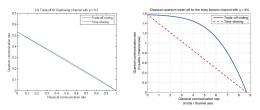April 16, 2012 feature
Trade-off coding for quantum communication provides more benefits than previously thought

(Phys.org) -- In optical communication systems, the overall performance depends on the strategy used to transmit photons from one location to another. In previous attempts to optimize this performance, scientists found that there is a trade-off between three transmission strategies: classical communication (measured in bits), quantum communication (measured in qubits), and shared entanglement (measured in ebits). But previous research has also suggested that the benefits of using this knowledge to implement “trade-off coding” strategies were too small and the coding too complex to have practical value. Now in a new study, scientists have found that trade-off coding strategies can in fact have remarkable performance gains when communicating over an optical channel compared with other traditional optical communication strategies. The finding could lead to transmitting classical and quantum information simultaneously at much higher rates than is possible with other techniques.
The scientists, Mark M. Wilde and Patrick Hayden of McGill University in Montreal, Quebec, and Saikat Guha of Raytheon BBN Technologies in Cambridge, Massachusetts, have published their study on the performance gains of trade-off coding in a recent issue of Physical Review Letters.
As the scientists explain in their paper, the quantitative study of a channel’s ability to transmit information was initiated by Claude Shannon in 1948. But while Shannon's theory can successfully determine the capacity of a purely classical channel, it does not account for the quantum properties of channels that are inherent to optical-fiber or free-space communication. Since quantum effects can increase the rate of information transmission, Shannon's law does not determine the true channel capacity. In the past several years, scientists have worked on extending Shannon’s theory to quantum channels in an attempt to determine the true capacity of communication channels, but more work is needed to fully understand the nature of quantum information transmission.
To better understand channel capacities, scientists have also been investigating specific coding strategies that use a combination of classical and quantum techniques, with the goal of finding a strategy that maximizes data transmission rates for both classical and quantum data.
“Suppose you would like to send photons at different time instances over a fiber-optic cable (and suppose further that you're allowed as many 'uses' of the channel as you want, with each time instance being a use),” Wilde told Phys.org. “You might want to use the channels for reliably transmitting classical data (as is the case nowadays), or you might want to use them for reliably sending quantum data (hopefully at some future point when quantum computers become ubiquitous in society). Or you might want to use the channels for transmitting both kinds of data. In this latter case, there will be a fundamental trade-off between how much classical data you can send and how much quantum data you can send. Ideally, we'd like to know in principle what are the maximal possible rates for communicating both kinds of data simultaneously, and this is what we're looking at in the paper.”
One strategy for maximizing both classical and quantum data transmission rates is trade-off coding, in which both encoded bits and qubits can be fed into the same channel input. This ability allows for using a small fraction of the overall available photons for the quantum part of the code, while using the rest for classical data transmission. If the code were to use more photons than needed for the quantum component, then these photons would effectively go to waste when instead they could be used for the classical component. The strategy differs from the simpler time-sharing strategy, in which the channel uses are divided up so that for some number of them, you use the best possible strategy for communicating classical data, and for the remainder of the channel uses, you use the best strategy for sending quantum data. As the scientists explain, the trade-off coding strategy can be thought of as a “power-sharing” strategy that packs in extra classical information in a clever way. Although this trade-off sounds advantageous, previous research during the last decade suggested that the benefits might generally be very small.
“Igor Devetak and Peter Shor had actually calculated the optimal trade-offs for a dephasing channel, a type of quantum noise dominant in superconducting qubits, for example, and the benefits were so small that it wouldn't really be that useful to employ a trade-off coding strategy for these channels,” Wilde said. “However, the benefits of trade-off coding depend on the channel over which you're sending information. In the present work, we show that the gains are surprisingly high for a class of channels known as bosonic channels, which are a quantum-mechanical model for free-space or fiber-optic communication.”
Although trade-off coding requires more complex encoding and decoding methods, the new results show that the pay-off is great enough that it should be considered in any practical implementation. In the future, the scientists hope to lay out a full, structured architecture for implementing trade-off coding for bosonic channels.
“The payoff is that communication rates can be significantly higher than one might naively expect when employing a time-sharing strategy,” Wilde said. “In our paper, we show that this is possible in principle if the only constraints are the laws of quantum mechanics, but we did not outline a practical encoder/receiver architecture in terms of known optical components that can realize these gains. This is the subject of ongoing research.”
More information: Mark M. Wilde, et al. “Information Trade-Offs for Optical Quantum Communication.” PRL 108, 140501 (2012). DOI: 10.1103/PhysRevLett.108.140501
Copyright 2012 Phys.Org
All rights reserved. This material may not be published, broadcast, rewritten or redistributed in whole or part without the express written permission of PhysOrg.com.

















